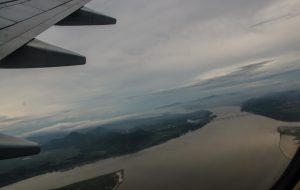It may not be outlandish to conclude that the sanction given by China’s recently held National People’s Congress, the ceremonial legislature of the country, for construction of hydropower dams near the Great Bend of the Brahmaputra river (which the Chinese refer to as Yarlung Tsangpo) and a railway link from Yaan in Sichuan to Nyingchi in Tibet is an important component of Beijing’s overall security strategy in South Asia. Suggestions have come from important quarters that hydroelectric dams near the Great Bend are only parts of President Xi Jinping’s efforts to absorb in infrastructure projects parts of idle Chinese workforce. But China has its Belt and Road Initiative (BRI), being implemented in different parts of the globe. This can absorb much greater numbers of the country’s labor force than what hydropower stations in Tibet can do. So why should China undertake such an environmentally risky venture near the Great Bend of the Brahmaputra except for security related advantages?
The plain answer is that China wants to maintain continuous pressure on India — be it all along the Himalayan range or the Indian Ocean region. It is plausible the Ladakh sector will witness a lull in hostilities between India and China at least for some time to come. True, a hydropower station near the Great Bend of the Brahmaputra had occupied its own space in official Chinese discourse since 2007-2008 when interested quarters had pushed for its inclusion in China’s 12th Five Year Plan. The proposal was shelved at that time, but Beijing undertook to develop the Bome-Medog highway, an infrastructure development initiative which always precedes construction of any big project. Obviously, this Chinese initiative carried meaning. The Great Bend of the mighty river is situated in the Medog county of Tibet.
There are divergent opinions about the impact of the proposed cascade of dams near the Great Bend, an area where the Brahmaputra enters India’s Arunachal Pradesh after more than 2000 meters fall over a few kilometers of areas. A near unanimous opinion is that the project is dangerous from an environmental point of view as the area is geologically unstable and therefore prone to earthquakes. In addition to this proposed project in the lower reaches of the Brahmaputra, China has already commissioned the Zangmu dam in the middle reaches of the river and three other such dams are coming up at Dagu, Jiexu and Jiacha, all in the same geographical location.
Among Indian policy analysts there are different opinions about the exact number of dams that China has been building up in the Brahmaputra basin in Tibet. Some non-governmental organizations (NGOs) have averred that 35 dams are now coming up in Tibet over the Brahmaputra river — eight on the mainstream of the river and 27 more on its tributaries — while according to another school of opinion China will build 20 dams on the Brahmaputra itself. China has never come clean on the exact number of dams it intends to build but has always assured that those will be run-of-the-river types and so there is no question of blocking the water flow of the mighty river. But even run-of-the-river type projects require dams and therefore lessening of the river water flow is a stark reality.
So a massive hydropower project at the Great Bend is certain to have its effects on the quantity of water in the Indian part of the Brahmaputra although some experts believe that the negative effect may not be as stupendous as it has been made out in certain quarters. It is because the Indian portion of the Brahmaputra receives the majority of its water supply from massive rains in the catchment areas of its tributaries. Moreover, Pranab Kumar Roy, director of Kolkata-based Center for Hydro Meteorological Research, has opined that only about 4 percent of the Brahmaputra water is utilizable due to flow rate and sheer volume of the river. So around a 10 to 20 percent shortfall in the river’s upper reaches will not affect the total availability of water in the Indian side.
But on March 1, 2012 the Brahmaputra had run completely dry at a place called Pasighat in Arunchal Pradesh of India. Does any river anywhere in the world have such a history? After a few hours the Brahmaputra became filled up with onrushing water of some great height inundating the Pasighat town. Does that not indicate blocking of water at upper reaches first and then its sudden release?
But geology is not on China’s side and this is a potential danger for India too as all of the Chinese hydropower projects mentioned above are situated in an area which is very close to the geological fault line where the Indian Plate collides with the Eurasian Plate. Therefore, all these plants will have to constantly live under the specter of earthquakes, one of which, measuring 7.9 on the Richter Scale, devastated the Three Gorges Dam on the Yangtze river.
Here lies the security threat to India. If the hydropower project at the Great Bend comes about then not only the Arunachal Pradesh but the whole of northeastern India will have to go to sleep with the possibility of breach of mammoth sized water reservoirs over its head at any time.

































